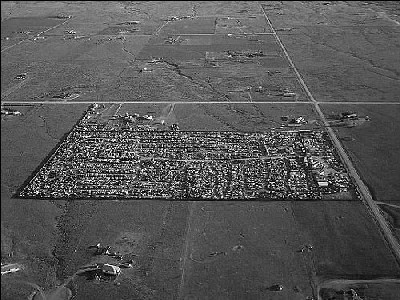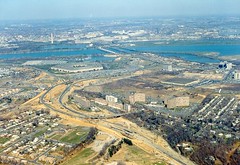More on the Maryland Growth Machine
 Sprawl unites us all (from A Field Guide to Sprawl by Dolores Hayden.)
Sprawl unites us all (from A Field Guide to Sprawl by Dolores Hayden.)I have discussed many times the work of Harvey Molotch ("The City as a Growth Machine" Am. Sociology Review, 1976) and John Logan and Molotch (Urban Fortunes: A Political Economy of Place) which discuss local political machines and the development ("growth") agenda that dominates it.
In the duh department, today's Post has a follow-up article on the Maryland Inter-County Connector freeway linking Montgomery County to I-95 in Prince George's County in the Business Section, entitled "More Intense Development Likely With Md. Connector".
With the printed article, but not the online version, is a map with various developments likely to be underway along the freeway route. Interestingly enough, one of the developments--"Hailey Development plans to put 50 to 60 townhouses on roughly 20 acres"--shows the difference between suburban development patterns and urban ones.
This number of rowhouses could be accomodated on one city block (including the interior of the block) which in the L'Enfant City (the part of the District of Columbia designed by Peter L'Enfant back in 1791) averages about 270 feet x 270 feet, and totals about 1.67 acres. (Fewer houses are present on city blocks outside of the L'Enfant City.)
With the same amount of land in the city, 600 or so houses could be constructed--and DC has smaller rowbuildings compared to cities like Philadelphia or the boroughs of Brooklyn or Manhattan in NYC. Of course we do have less land inventory, which is why the price of land and houses is rising so rapidly right now.
Even more housing units could be accomodated in the city with slight changes in the configuration and height of the buildings. I've been meaning to write about this article for awhile: "Getting to Know the Plex: An Urban Housing Solution That’s Invigorating Neighbourhoods from Chicago to Montreal," which discusses multiple unit flats or "plexes" which are common in other cities but not DC.
But back to the Growth Machine...
Today's Post editorializes in favor of the intercounty connector in "One Step Closer," at least I think it does, as some sort of triumph of ideas being translated into action--"Now, 55 years after it was first conceived, this intercounty connector is showing signs that it might -- as early as next year -- cease to be just an idea and start to become an actual, tangible highway"--over "archaic procedures involving bureaucrats writing letters back and forth to work out every last detail."
Plus, the editorial positively endorses the the scrapping of traditional environmental impact reviews (NEPA and NHPA reviews--and I have written before about the pressure of the Bush Administration to gut such reviews, particularly with regard to Highway projects)--in return for speed.
Not good.
Today's Baltimore Sun, perhaps because it is attuned to the transportation needs across the State of Maryland, is less ecstatic in its editorial, "The Fast Lane:"
So what are taxpayers getting for $2.4 billion? Perhaps it's best to be reminded of what they aren't getting. The ICC will not solve Montgomery County's traffic congestion woes. As traffic studies make clear, the Capital Beltway isn't about to become unclogged, nor will Interstate 270 be emptied. The more compelling argument is how the ICC might spawn future development - perhaps 14,000 jobs, according to one University of Maryland study. Certainly, the ICC would better connect portions of Prince George's County, Baltimore-Washington International Airport and the rest of Central Maryland with job-rich Montgomery County and the I-270 technology corridor.
That's a compelling argument, and the Ehrlich administration has helped its cause further with its plans to ameliorate some of the environmental harm caused by the road. But it's the huge cost of the ICC that remains daunting.
Even as the State Highway Administration prepares to spend $133 million per mile on a new road, the state is simultaneously reducing Maryland Transit Administration bus service in the Baltimore region, in part, to save a comparatively paltry $5 million a year. To put it bluntly, the Ehrlich administration has failed to meet Maryland's multibillion-dollar transit needs - from the popular but aging Metro system in the D.C. suburbs to Baltimore's multimodal mess. Starving transit to help feed highways is a poor tradeoff. The ICC's funding scheme is far from ideal - an unusual mix of tolls, tax dollars and record borrowing that can only add to the imbalance for many years to come.
Mr. Ehrlich has treated the ICC as the Great White Whale of transportation, the focus of his attention (after slot machines, we imagine).
And while we agree that the ICC is a worthy investment in Maryland's economic future, so is an efficient and effective system of buses, subways, commuter trains and light rail lines. Public transit can relieve congestion - and improve quality of life - in ways that roads cannot. Before Maryland spends such a staggering amount of money to pave a new highway across Montgomery County, the administration ought to offer an equally ambitious strategy for addressing the growing needs of the neglected Metro and MTA systems. (emphasis added)
 Shirley Highway under construction in 1971, from the Roads to the Future website about the development of highways in the DC-Maryland-Virginia region.
Shirley Highway under construction in 1971, from the Roads to the Future website about the development of highways in the DC-Maryland-Virginia region.Today's Post also has an article, "A Three-Day Jam at Wilson Bridge: Closures, Detours This Weekend Could Stall Traffic for Miles," which could be thought of as an article about the success of roads as a mobility strategy... Am reading Kunstler's The Long Emergency right now and he quotes statistics that the average U.S. household makes 11 automobile trips each day. You can't build that many roads to accommodate that number of trips.



0 Comments:
Post a Comment
<< Home